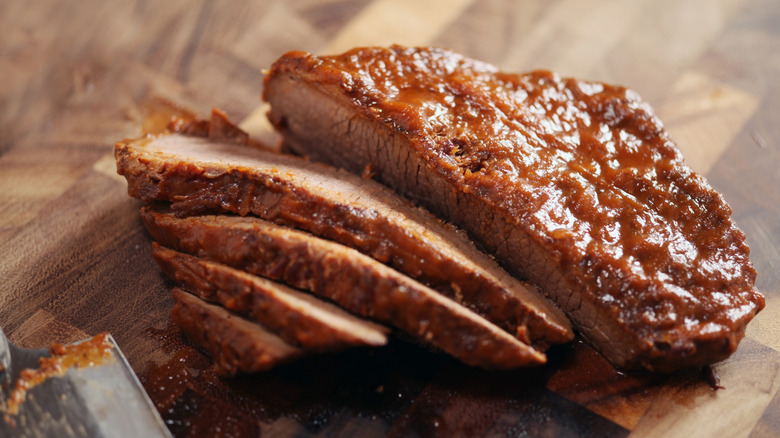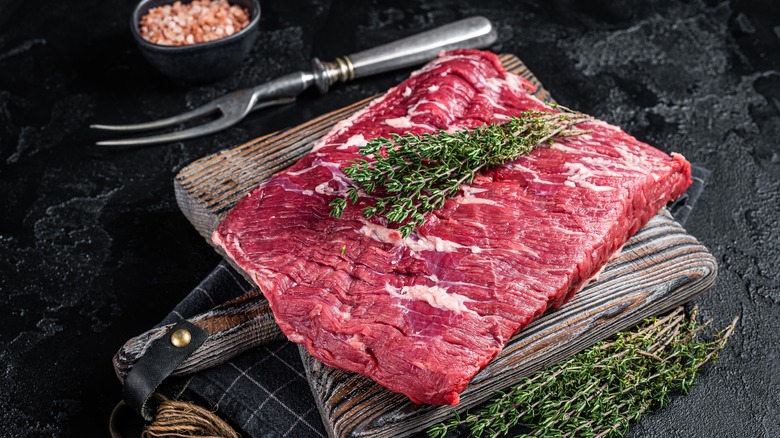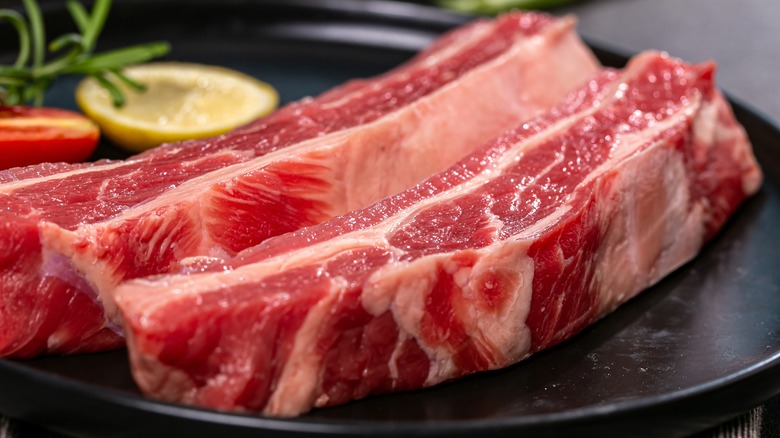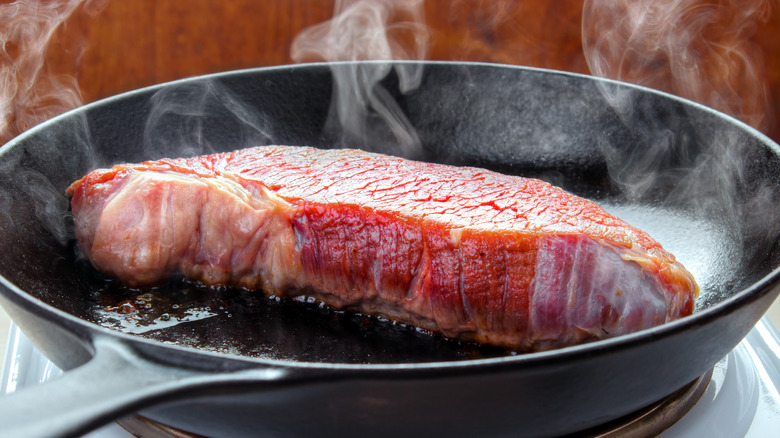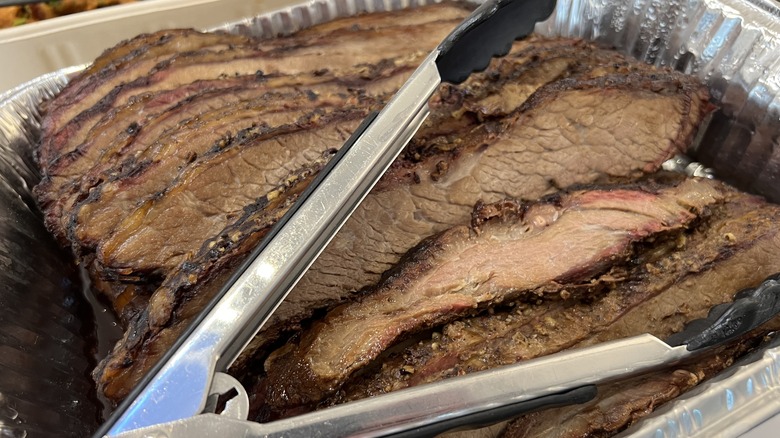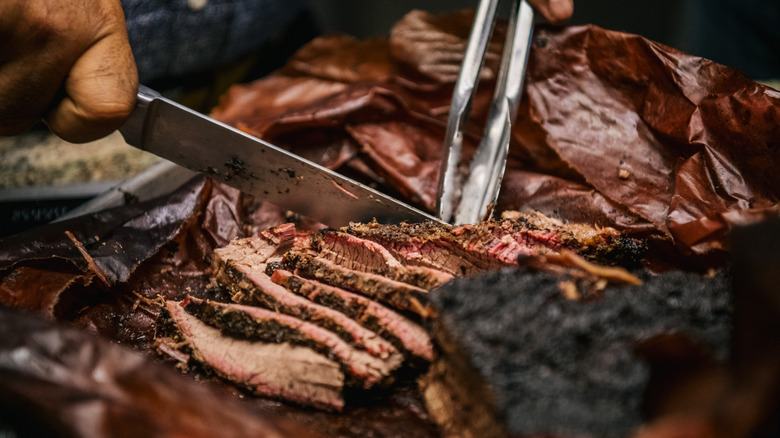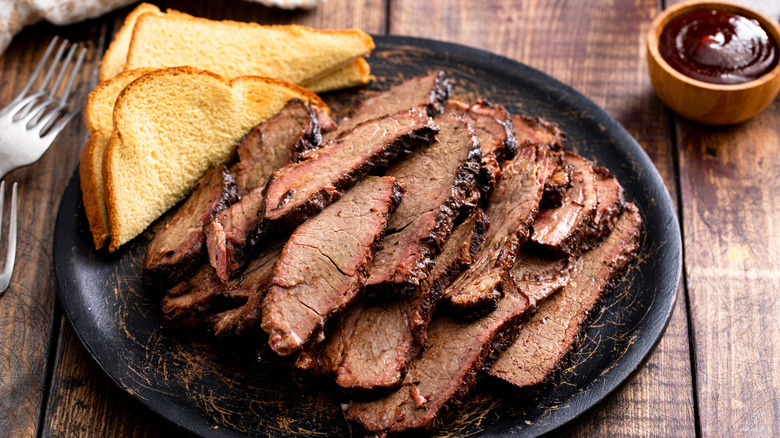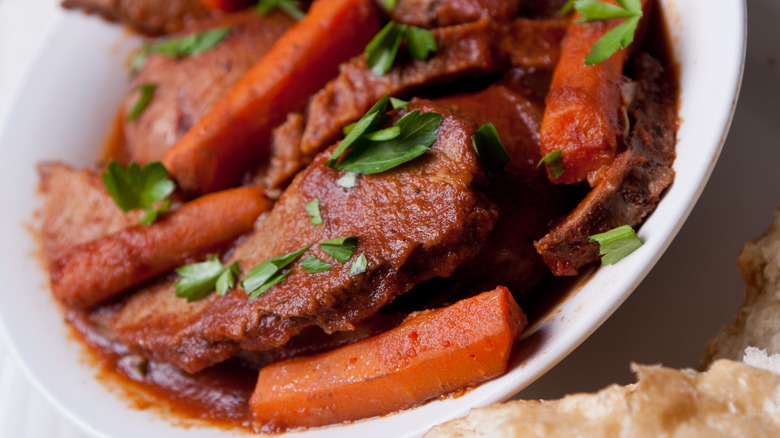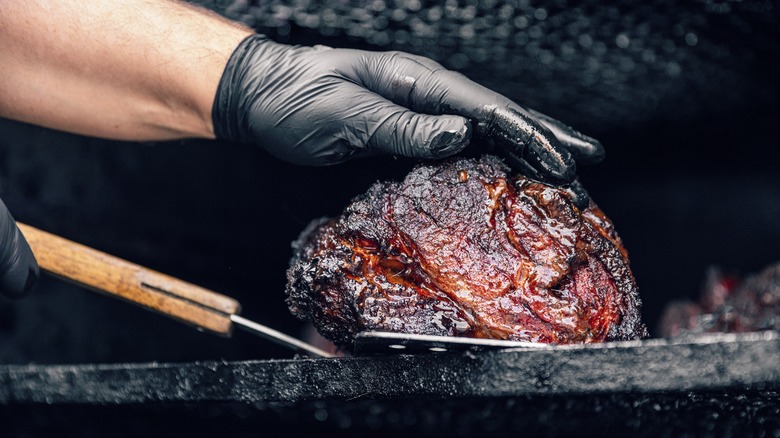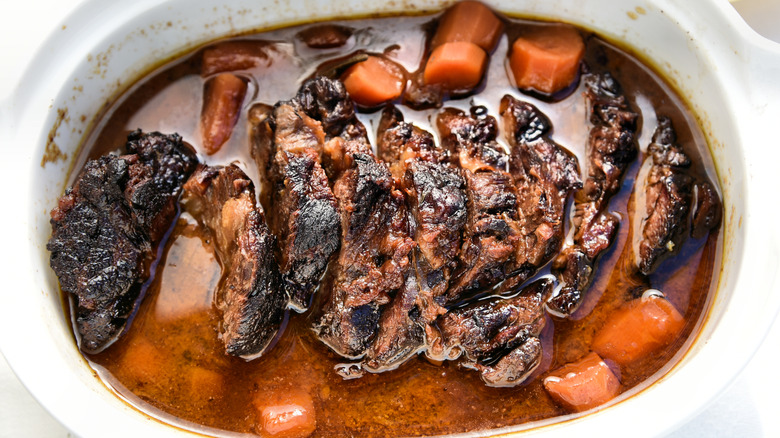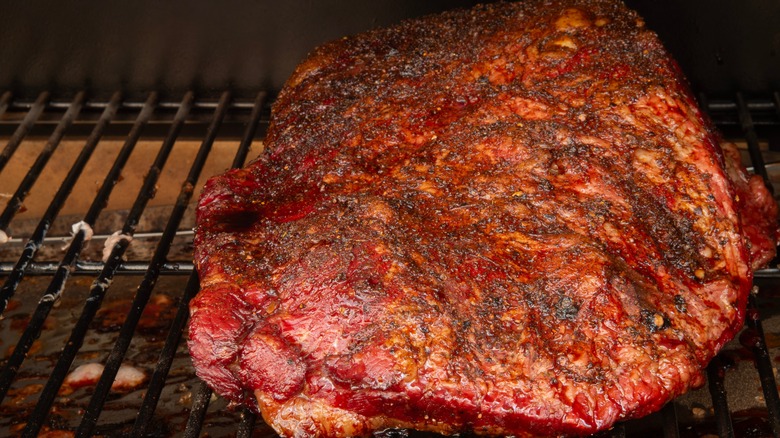Chefs Claim These Mistakes Are Ruining Your Brisket
Brisket is among the most beloved cuts of meat for good reason — whether served as a hearty Passover braise or long-smoked by that gifted pitmaster you happen to know. While it's no longer the bargain cut it once was (its cheapness was what made it so popular), it continues to have loyal fans who appreciate its richness and deep, meaty flavor. While rarely considered a super-fancy dish, a well-made brisket is always a cause for celebration.
Typically, brisket is a rustic, hearty preparation, but this doesn't mean it's easy to make. Brisket is a tough, fibrous cut (one of the reasons it was once so affordable), so it requires long, careful cooking, whether you're braising it indoors or smoking it outdoors. But both cooking techniques are laden with potential pitfalls for inexperienced or inattentive cooks: If you fail to exercise patience and don't pay attention, you can end up with dry, tough meat or a flavorless, fatty mess. The secret to brisket success is to learn from experts who've mastered the tricky cut. We've asked a few chefs about the mistakes people often make when preparing brisket — and how to avoid them. Here's their responses.
Choosing the wrong cut of brisket
A big mistake among home cooks is to assume that all brisket is alike, so any piece of brisket will work in any dish. Unfortunately, this isn't the case. The brisket is actually a large cut with two parts, the leaner, rectangular flat and the fattier, triangular point. Flats and points are often packaged and sold separately, so it's important to know which one you've got so you'll know the best way to cook it.
The best cut for you will depend on your taste and how you plan to prepare it. "I always go for the flat cut — it's your best bet for a nice, even cook and it slices up real pretty," says Bricia Lopez, owner of the James Beard Award-winning restaurant Guelaguetza and Lee Kum Kee partner. "Steer clear of pieces with patchy fat or ones that are too thin — they can dry out faster than you'd like," she said. The point, however, also has its fans. "I look for brisket with excellent marbling — nice marks of white fat that are naturally intertwined into the red meat — and good moisture, which you typically find in the point," says Dustin Green, head grill master at Weber. And David Rose, the head chef at Omaha Steaks, recommends splitting the difference and using a whole packer brisket. "This cut includes both the flat and the point," he explains. "The flat is leaner and good for slicing, while the point is fattier and great for burnt ends."
Using poor-quality meat
Many cooks wrongly believe that the quality of their brisket doesn't matter. But as programmers say, garbage in, garbage out. "People who cook great brisket begin with great brisket," explains Barrett Black, a fourth-generation pitmaster at the Original Black's Barbecue in Texas.
First, ensure your meat is fresh. "The brisket should have a rich, deep red color and a slight smell of freshness. Avoid any that look pale or have an off smell," advises David Rose of Omaha Steaks. "To ensure you're getting the best quality meat, shop at reputable butchers or stores known for their fresh produce," Bricia Lopez, Guelaguetza, adds. "A busy shop usually means the meat hasn't been sitting around too long, so that's always a good sign." In addition, the right amount of fat can make or break a brisket. "Look for good marbling and avoid briskets that are too big," Black says. "A good range for a raw whole packer brisket is about 12-15 pounds. Larger briskets often have more fat, but not the intramuscular fat/marbling that we want."
Also, Erica Blaire Roby, pitmaster and Food Network "Master of Cue" champion, explains you should buy the right brisket for the occasion. "Am I making a smoked brisket chili? Then I would pick choice," she says. "Am I going to a BBQ competition? Wagyu it is! Am I having a nice dinner party BBQ in my backyard? Prime is a great choice."
Not searing before braising
For home cooks, the most familiar brisket preparation technique is a long, slow braise. But a critical step to this method — the initial sear — is an easy one to forget. "Sear the brisket on all sides before braising," says David Rose, head chef at Omaha Steaks. "This step adds depth of flavor through the Maillard reaction." (For those who aren't kitchen chemistry geeks, the Maillard reaction is the interaction of proteins and sugars that takes place when meat is browned; it lends the complex, earthy flavors we associate with browned meat.)
A good sear not only supercharges the flavor of a braised brisket, it adds textural and visual appeal. "Always brown your brisket before you braise it — this seals in the juices and gives it a nice crust," says Guelaguetza chef Bricia Lopez. But for cooks who braise their brisket in the oven and find stovetop searing time-consuming and messy, there's a solution: Put the brisket with its braising liquid and aromatics directly in the oven, but ensure the top surface of the meat is above the liquid. The oven's heat will brown the exposed surfaces, even if the pot is covered. Turn the brisket a few times to ensure the entire piece gets some direct heat.
Using too high heat
While cooking brisket is largely a hands-off process, it's a lengthy one that rewards patience and planning. Pitmaster Erica Blair Roby notes that it can take 13-plus hours — smoking, braising, or oven-roasting brisket is an all-day commitment that you shouldn't rush. And whether you're braising or smoking your brisket, the experts agree a low cooking temperature is crucial. "Low and slow is the way to go; let it simmer gently and it'll get melt-in-your-mouth tender," says chef Bricia Lopez. For smoking, Lopez suggests that cooks "aim for a cool 225 [degree] Fahrenheit" smoking temperature.
But for those of us who don't cook brisket often, it can be easy to get caught flat-footed by the long cooking time. If your brisket is only halfway done and dinner guests are on their way, you may be tempted to speed things up by cranking up the heat. Unfortunately, this won't work. "Avoid cooking at high temperatures, which can make meat tough," warns David Rose, Omaha Steaks. "While higher heat may cook brisket faster, it won't allow for the breakdown of connective tissues needed for tenderness. Low and slow is key."
Relying on time alone to determine doneness
Most home cooks have a handful of tried-and-true recipes that always turn out great — as long as they follow the instructions, they get the same tasty results every time. Unfortunately, recipes for brisket are not among these. Just because your last brisket came out perfect after 11 hours of smoking doesn't mean your next one will. This is because each cut of brisket is unique and requires its own approach to its preparation. "Different parts of the brisket cook differently," explains chef David Rose. "The flat and the point require different attention during the cook due to their varying fat contents."
Thus, while you can estimate your expected cooking time from the weight of your brisket (John Rivers, founder of 4 Rivers Smokehouse, assumes around 75 minutes per pound when smoking), you can't just set a timer and expect success. For better results, use the meat's internal temperature to measure for doneness. "It's crucial to ensure your brisket is at least 195 Fahrenheit to avoid over or under cooking your brisket, and you can achieve this by using a probe meat thermometer to check the temperature," says chef Erica Blair Roby.
It also helps to pay attention to details, such as choosing a good cut of meat, trimming it carefully, and minding the cooking temperature. "Any smoker and any person can cook a great brisket with the knowledge of what to look for, what to pay attention to, and a lot of patience," adds Barrett Black, pitmaster at The Original Black's Barbecue in Texas.
Forgetting to let brisket rest before serving
When the experts warn that great brisket requires time and patience, they're not joking. Even after a day-long smoking session or a slow, hours-long braise, your brisket is still not ready to serve. To ensure your guests get brisket at its best, you must allow the meat to rest before you carve and serve it. This rest period allows the muscle fibers in the meat to relax and allows the juice to be evenly reabsorbed into the meat. This ensures the meat will be tender and juicy when enjoyed.
The length of the rest period depends on the size of your brisket and your tastes. "Let your brisket rest at least an hour after smoking," says chef David Rose. Some chefs, however, do prefer a longer rest. When resting brisket, chef Barrett Black uses internal temperature, rather than time, to determine when the meat is ready to serve. "Do not slice until the internal temp has come down to about 150 [degrees] Fahrenheit," he urges. In short, to calculate how much time you need to bring a cooked brisket to the table, estimate your cooking time — and add a few more hours.
Resting your brisket too long
As we all know, too much of anything can be problematic. While your brisket will taste better and slice more easily if it has had adequate time to rest, too much rest time can cause problems of its own. "While resting is important, resting for too long can cause the meat to cool and dry out. Aim for a balance, usually between one to two hours," says chef David Rose.
Some cooks prefer a longer rest period, however. And on occasion, logistical constraints require holding briskets overnight. This is not ideal, but if you must rest your brisket for extended periods, be cautious about temperature control to avoid the chance of bacterial growth and potential food poisoning. To keep the meat at a safe temperature (just over 140 degrees Fahrenheit) during a long rest without overcooking it, put it in a good-quality insulated cooler with an electric heating pad set to 140 degrees Fahrenheit. Use a digital thermometer to ensure your meat stays safely warm.
Opening and closing your smoker too often
Experienced pitmasters understand that a perfect smoked brisket is a product of skill and hard work. "Cooking brisket is an art that requires patience and practice. It's one of the more challenging cuts to perfect," says David Rose, head chef at Omaha Steaks. While smoking a brisket involves a lot of hands-off waiting, you'll also need to check on the brisket several times while it cooks. For instance, chef Erica Blaire Roby rotates the meat every hour for an even cook and puts a foil pan of water in the smoker to ensure the meat stays moist. Moving the meat and monitoring the water level both require opening the smoker.
But while you'll need to check your brisket and the conditions inside your smoker regularly, you don't want to overdo it. "Don't open the smoker frequently as it disrupts the cooking temperature," urges pitmaster Barrett Black of The Original Black's Barbecue in Texas. Rose offered similar advice. "Each time you open the smoker, you lose heat and smoke," he explains. "Try to maintain a stable environment by keeping it closed as much as possible."
Over-smoking your brisket
If you're going to all the trouble to smoke a brisket, you want to taste the smoke. Indeed, pitmasters treat wood smoke as a central part of their brisket seasoning and so they're picky about the type of wood they use and its quality. "Use a dense hard wood like oak or hickory that has been dried for at least six months or kiln-dried," says pitmaster Barrett Black.
But while you want your brisket to turn out pleasantly smoky, you don't want it to smell like an ashtray. And you want the smoke to complement the flavor of the beef, not overwhelm it. So try not to overdo the smoke. To ensure your brisket has a clean, aromatic smokiness without any bitter or ashy notes, avoid putting it in the smoker until the wood has passed through the initial stages of combustion, during which time it will emit thick, gray smoke. "Before I add the brisket, I make sure the smoke is just right, meaning any gray smoke is gone," explains Dustin Green, head grill master at Weber.
Allowing brisket braising liquid to dry out
One of the best things about a good braised brisket is the luscious sauce that emerges from the braising liquid. Enriched with meat juices and softened aromatics and thickened by hours of careful cooking, it's the best possible accompaniment to a savory bite of brisket or a forkful of simple mashed potatoes or tender egg noodles. Besides flavoring the meat, the braising liquid serves the all-important purpose of keeping the brisket moist and helping it stay tender as it cooks. So to ensure your braised brisket turns out tender and saucy, watch the liquid levels and do not allow the precious braising broth to dry out.
A good way to keep the liquid from drying out is to keep the brisket covered during the braise. "Use a heavy-duty, oven-safe pot with a tight-fitting lid. Braise at low temperatures and ensure the liquid covers at least two-thirds of the meat," says pitmaster Barrett Black. But while a moist, saucy brisket is a thing of beauty, a soggy, soupy one isn't. And chef David Rose notes that you should use just enough liquid to partially submerge the brisket — but not too much liquid, otherwise you'll drown it. He says, "This balance keeps it moist without boiling it."
Not keeping a steady smoker temperature
As many novice pitmasters have discovered to their dismay, brisket can behave unpredictably in a smoker. Despite our best efforts, it can come out tough and dry (or undercooked) even after a long bout in the smoker. One of the possible reasons for this is fluctuating temperatures in the smoker itself. And the experts agree: For consistent results, you need to maintain a consistent temperature. "Keep your smoker steady — temperature consistency is key to a perfect brisket," says Bricia Lopez, restaurateur and cookbook author. A good thermometer will help you keep tabs on the smoker and meat temperature.
But keeping a steady temperature when working with smoke requires some finesse. A container of water inside the smoker will not only keep your brisket from drying out, it will help keep the temperature inside the smoker stable. Opening or closing the smoker's vents can also modulate the temperature: Wider openings draw in more oxygen to feed the fire, and thus raise the smoker's internal temperature. Closed or partially closed vents can slow down the fire and keep temperatures low. For long, slow smoking, keep both the top and bottom vents mostly closed, at least 75% of the way.

